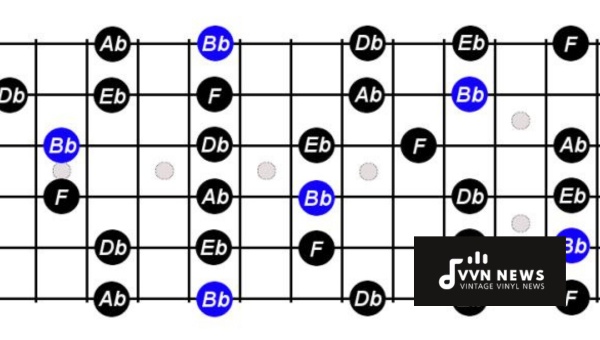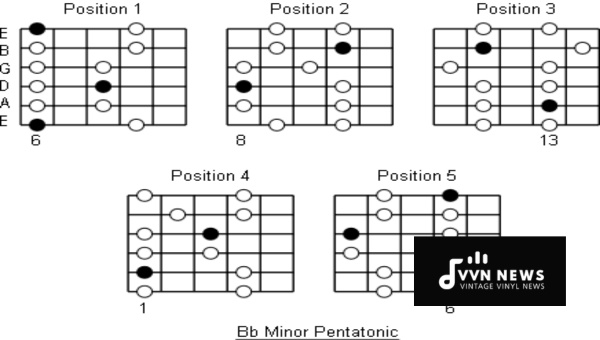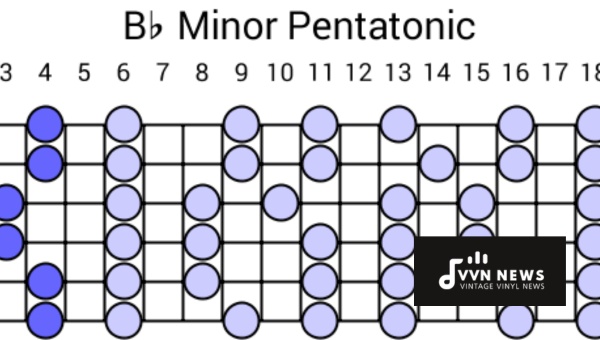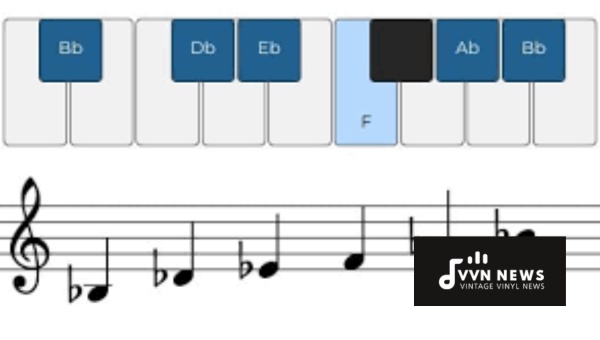If you’re learning to play a musical instrument, discovering new scales can be truly invigorating.
One such notable and melodically arresting scale that has a unique charm to it is the b flat minor pentatonic scale.
Fasten your seatbelts, because we’re about to embark on a fascinating ride through the intriguing world of this quintessential music scale.
Though it might sound intimidating at first, I assure you that becoming familiar and proficient with the b flat minor pentatonic scale is less challenging than it seems.
This captivating array of notes carries an energy unlike any other, tenderly nudging novice and seasoned musicians alike toward new musical frontiers.
So let’s turn the page together on another chapter in our continuous musical education!
Components of the B Flat Minor Pentatonic Scale
The B Flat Minor Pentatonic scale is composed of five unique notes. These notes are:
- B flat (B♭) – often regarded as the ‘tonic’ or main note.
- D flat (Db) – which adds depth and character.
- E flat (E♭) – adding a touch of sharpness to the scale.
- F sharp (F#) – that creates a resonating effect.
- A flat (Ab) – rounding off the collection in just the right manner.
Each note plays an imperative part in lending to its distinctive sound, and together, they give rise to a pure harmony that comes with playing this alluring minor pentatonic scale.
These are not random notes but rather a beautifully organized sequence carefully curated to produce a mesmerizing melody when played together.
Also Read: A Flat Minor Pentatonic Scale [Unleash Subtle Tension In Your Music]
Steps to Form the B Flat Minor Pentatonic Scale

Forming the B Flat Minor Pentatonic scale may seem tricky, but I assure you, it’s an achievable task.
To begin, let’s familiarize ourselves with the structure of a classic minor pentatonic scale formula: 1-b3-4-5-b7.
- Start with the B flat note as your root (1). In music theory, we represent this as ‘Bb’.
- Move to the minor third (b3). This will be three half steps up from your root, landing you on Db.
- Next, find your perfect fourth (4), which is five-half steps up from your root note. This brings you to Eb.
- Continue upwards to your perfect fifth (5), seven half steps up from ‘Bb’, reaching F.
- Lastly, locate your minor seventh (b7). This is placed ten-half steps above your root note and will land you on Ab.
Your final B flat Minor Pentatonic scale Bb – Db – Eb – F – Ab is now ready! This five-note sequence unveils a new melodic landscape for exploration.
Mastering this sequence opens doors to a world of intriguing harmonic possibilities.
Conquer this daring musical test and enjoy the rewarding melodies that follow! K
Unveiling the Shapes of the B Flat Minor Pentatonic Scale
Next, let’s delve deep into the mesmerizing shapes of the B Flat Minor Pentatonic scale.
Spread across the entirety of your instrument’s fretboard, these shapes can provide you with new tools to express yourself musically.
Open Position
The easiest shape to try your hands on is the Open Position. Just like learning our first language, an open position builds up as an instinctive point of reference — it’s where you kick-start all! The first position uses just three frets; frets one through three.
The Box Pattern
Your next stepping stone should be The Box Pattern. Think of this pattern as a musical playground.
It occurs at around frets 3 and 6 and is so named because it resembles a box – four parallel frets bunched together with no movement needed up or down the neck.
The A-Form
Then we find ourselves exploring The A-Form, which is formed by shifting your hand down to play at around frets 6 through 9.
You’ll see why it’s called A-form once you practice it across your instrument — it forms an “A” shaped note cluster.
Spanning Frets
Next, comes a slightly tricky one titled Spanning Frets, which spans notes between around frets 9 and 12. The crux here lies in stretching oneself beyond the comfort zone.
Dynamic Shift
Finally, we reach a Dynamic Shift. This shape requires your hand to dynamically shift between two positions.
For instance, you might start playing around fret 1, and rise to play at fret 4 for a while before descending back to its original position.
To effectively learn these shapes, consider dedicating daily practice sessions to executing each one perfectly.
Also Read: G Flat Minor Pentatonic Scale [Interesting Tones For Your Music]
Minor and Major Keys for the B Flat Minor Pentatonic Scale

When assessing scales, it’s crucial to grasp how they interlock with both major and minor keys.
These associations establish harmony as well as dissonance, providing the building blocks for music composition.
Let’s take a closer look at how the B flat minor pentatonic scale fits in this admirable musical matrix:
The Minor Element
Originating from its root note (B flat), the B flat minor pentatonic scale, as the name suggests, encompasses five distinct notes. The notation is quite simple: B♭ – D♭ – E♭ – F – A♭.
These enchanting elements dovetail into what we commonly recognize as minor.
The tones bristle with pathos, often releasing profound emotive content that can stroke our heartstrings or stir us towards contemplation.
What makes a pentatonic scale like ours so unique is its versatility. It has an uncanny ability to flow melodiously across numerous genres, including but not limited to blues, jazz, rock & roll, pop, and country music.
The Major Influence
In terms of major counterparts to our beloved B flat minor pentatonic scale; it correlates with the D Flat Major Pentatonic Scale (D♭ – F – G♭ – A♭ – C).
Recognizing this relationship is invaluable as it aids in illuminating fundamental links that facilitate seamless key transitions throughout various chord progressions.
Understanding how they interact forms a connecting bridge between theoretical education and practical application.
Deciphering these pairings when unraveling a new piece of music or improvising your solos can provide an incredible boost toward your musicianship advancement.
Every noteworthy musician recognizes that studying scales isn’t merely about memorizing finger movements on an instrument.
It thrives upon acknowledging how these bundles of notes co-operate within the vast, wondrous world of music.
Through honing insight into minor and major keys, we can continue to unfold our music capabilities layer by layer, revealing even more ways in which we can express ourselves through the divine language of music.
Steps to Practice the B Flat Minor Pentatonic Scale with Background Music
Learning a musical scale thoroughly necessitates practice and patience.
When diving into the remarkable world of the B Flat Minor Pentatonic scale, incorporating background music can significantly amplify your learning experience.
Here are some effective methods to integrate music while practicing this captivating scale:
Identify Key Points within the Scale
Highlight common and significant notes in this unique scale. Pay special attention to those that have a melodic or harmonic bearing on the songs you’re working on.
For instance, in a B Flat minor pentatonic scale, these notes would be Bb, Db, Eb, F, and Ab.
Listen Actively
Active listening can be an extraordinary tool for you while getting accustomed to the B flat minor pentatonic scale.
Choose compositions that extensively use this scale and focus on identifying its distinct sound.
For example, Miles Davis’ album “Kind of Blue” is touted as an excellent opus featuring numerous b flat minor pentatonic licks.
Jam Along with Tracks
Incorporate your new skills into real-time music play. Pick tracks rich in the B Flat Minor Pentatonic Scale and start your jamming session.
This practice can help cement your connection with these notes by integrating muscle memory into your learning journey.
Record Your Practice Sessions
This allows you to revisit them later for self-assessment and correction of any issues not obvious in real time.
Frequent review helps identify blind spots or stumbling blocks unseen during live practice sessions.
While practicing it’s okay and very natural to hit roadblocks or face challenges.
What’s important is keeping your spirit alive and maintaining a disciplined approach towards perfecting this beautiful musical concept.
Also Read: D Flat Minor Pentatonic Scale [Spice Up Your Melodies Today]
Renowned Songs Utilizing the B Flat Minor Pentatonic Scale

The B flat minor pentatonic scale is known for its moody, soulful undertones and has been incorporated into various memorable songs across the musical spectrum.
Here’s a list of five well-known pieces that have masterfully captured its essence:
- Pink Floyd – “Comfortably Numb”: Among the most legendary songs globally, “Comfortably Numb” exploits the melancholic tone of B flat minor pentatonic scale to convey its profound narrative. The song’s unforgettable guitar solo impeccably expresses this scale’s dynamism.
- Michael Jackson – “Billie Jean”: This iconic pop hit powerfully resonates with this scale’s intonation. It maneuvers through harmonious transitions, personifying the ‘dark and dreary’ energy tied to B flat minor pentatonic scale.
- Led Zeppelin – “Stairway to Heaven”: An anthem that resounds through the ages, Led Zeppelin’s magnum opus is a complex musical saga dominated by various scales; among them, the scope of B flat minor pentatonic feels highlighted, particularly in its climactic guitar solo.
- The Eagles – “Hotel California”: This consummate piece carves a remarkable space for itself within B flat minor pentatonic landscape. The enthralling dual guitar solo that concludes the track contributes to this legendary distinction.
- Deep Purple – “Smoke on the Water”: One of rock music’s monumental songs featuring an unmissable riff intertwines ingeniously with our hauntingly beautiful scale under discussion.
Incorporating these emblematic pieces into your practice sessions can open an exciting window into how seasoned musicians exploit this enchanting scale creatively and effectively.
So buckle up and immerse yourself in these masterpieces – they may be just what you need for your next breakthrough moment as an aspiring musician.
Also Read: E Flat Minor Pentatonic Scale [Master This Key With Our Guide]
FAQs About The B flat minor pentatonic scale
What is a B Flat Minor Pentatonic Scale?
The B Flat Minor Pentatonic Scale is a musical scale with five pitches per octave, in the key of B♭ minor.
Why should I learn the B Flat Minor Pentatonic Scale?
Learning the B Flat Minor Pentatonic Scale enhances your versatility as a musician and expands your abilities to play intricate melodies and solos.
Can I play the B Flat Minor Pentatonic Scale on any instrument?
Yes, the B flat minor pentatonic scale can be played on any instrument capable of playing pitches — like guitar, piano, or saxophone.
Is mastering the B Flat Minor Pentatonic Scale difficult?
While mastery takes time and practice, the simple structure of this scale makes it one of the easier ones to familiarize yourself with in the beginning.
Where can I hear examples of the B Flat Minor Pentatonic being played?
Many genres such as Rock, Blues, Jazz, and Country extensively use this scale – in lead playing and solos especially. Classic songs like “Purple Rain” by Prince are great examples.
Conclusion
In conclusion, learning the B flat minor pentatonic scale is not as daunting as it may initially seem.
It’s a beautiful expression of musicality that can propel your playing prowess to new heights.
Whether you’re a beginner looking for new scales to spice up your repertoire, or an experienced player seeking to deepen your knowledge of music, mastering this scale can open up a plethora of possibilities.
And remember, practice makes perfect. So stay patient, keep the rhythm going, and most importantly – enjoy the process! Happy playing!








